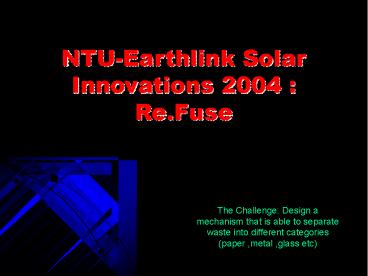NTU-Earthlink Solar Innovations 2004 : Re.Fuse PowerPoint PPT Presentation
Title: NTU-Earthlink Solar Innovations 2004 : Re.Fuse
1
NTU-Earthlink Solar Innovations 2004 Re.Fuse
The Challenge Design a mechanism that is able to
separate waste into different categories (paper
,metal ,glass etc)
2
Overview
Ferrous Metal Non-Ferrous Metal Plastic
Paper Other Junk
Ferrous metal removed by magnetic attraction
Non- Ferrous Metal Plastic Paper Other Junk
Non -Ferrous metal removed by infra-red detection
Plastic Paper Other Junk
Plastic and paper removed by air currents
Other Junk
Separated by flotation
Plastic
Paper
3
Separation of Ferrous Metals
- The rubbish is loaded on a conveyor belt and
moved along until it reaches the roller lined
with an electromagnet. - As it passes the roller, the electromagnet will
attract the metal to it, causing it to be
attached to the roller. - The metal then moves up with the roller and is
deposited into the collection bin. - The collection slide is positioned very near the
roller such that it will just scrape the metal
off the roller as the metal approaches it. - The remaining scrap material is carried on the
conveyor belt until it drops into the
funnel-shaped collection bin.
Animation
4
Separation of Non-Ferrous Metals
- Mechanism to extract non-ferrous metal
- Waste is loaded onto a platform full of pistons
- Heater heats up waste and metal
- Metal gains heat faster as it is a good conductor
of heat - Picture is taken by infra-red camera and it is
sent to computer which identify the hotspots - Pistons surrounding hotspots are fired which
encloses the non-ferrous metal of a higher
temperature - Mechanical arms tilt the platform, resulting in
the falling of other waste - The non-ferrous metals remain caged by pistons
- Pistons is then retracted and metal pushed by a
broom into collection bin - Process is repeated several times
Model
5
Separation of Non-Ferrous Metals
- Mechanism to operate piston
- To fire the piston, the valve for that particular
piston is opened and the pressure will force the
piston to fire out. - To retract the piston, the pressure is lifted and
the valve closed when the piston returns to its
original position. - The tip of the pistons are coated with
heat-resistant thermoform plastic, so that they
themselves do not register as a hotspot
6
Removal of Paper and Plastic from remaining waste
- The refuse is transported by conveyor belt into
the separation chamber - The fan is operated at high speed so that paper
and plastic in the refuse tend to fly up to the
height of the trap door - Within a few seconds, the trapdoor is closed.
Paper and plastic is then collected - Paper and plastic at the top of the chamber, and
remaining refuse at the bottom of the chamber,
are pumped out of the chamber by their respective
outlets.
Animation
7
Separation of plastic and paper
- The mixture is dumped into a transparent plastic
chamber filled with water. - Plastic materials float as they have a low
density - Cloth which is porous, soaks up water, becomes
dense, and then sinks. - However, plastic sheets could be trapped within
the soaked cloth at the bottom. - Bubbles are blown into the container and it stick
to the plastic, allowing it to float to the
surface. - On the other hand, no bubbles stick to cloth.
Model
8
Separation of plastic and paper
- Air pump is switched off.
- After the operator observes that cloth has
settled at the bottom, the flaps are raised.
Plastic and cloth are effectively separated. - Water is then drained so that plastic settles on
the separation flaps. - After separation, the upper pipe drains the
plastic together with out of the cylinder. Paper
is easily removed together with the fine net
lining at the base of the cylinder.
9
Benefits Unique features
- Environmentally friendly
- Smooth transit from one separation stage to
another - Handling of a large volume of refuse at any one
time - High degree of automation
10
Application
- Separation of recyclable materials
- Leftover materials can be sent for incineration.
Energy from incineration can contribute to power
grid.
11
THE END
NATIONAL JUNIOR COLLEGE
Teacher in-charge Ms Yee See Ling
Team members Tan Thong Lip Alvin Chan Li
Yun Chan Wei Sheng Daniel Fang Kok Boon Yeo Shi
Wei Jason

